Am I walking into eternity along Sandymount strand?
(James Joyce, Ulysses)
For those of you who have joined me on these walks, we are crossing the River Liffey today to the south side of the city. Because of the lovely curve of the bay, we still have a clear view of Howth (#!1) and in a short while we will be able to see Dollymount again (#2).

(Before we set off, a word about the photos – I’m using a compilation so the overall effect may appear disjointed – blue skies mixed with grey and so on ….)
We’re going to start here at Sandymount Strand where the lovely promenade offers great views of the bay. This is a fine walk in itself – from one end to the other and back is about 5km. But you’re not getting off that lightly! We’ll have a quick look around and head off…


The swimming baths were built in 1883. A 75-metre pier, complete with bandstand, was added the following year…. it must have been very fine indeed! By 1920, the pier had deteriorated enough to be demolished and it was never replaced. The baths are now in serious disrepair.

This is one of 28 Martello Towers built on the Dublin coast by the British in 1804. They were part of the defence system against the expectation of a Napoleonic invasion. The towers were always round, and typically two storeys in height, with stronger walls on the side facing the sea. Cannon would have been mounted on top. This particular tower appears larger than usual, with a one storey extension.
The tower was later used as an office by the Dublin United Tramways Company and also served as a cafe in the 1960s.
This 20-foot high metal sculpture, by Mexican sculptor Sebastián, was donated by Mexican President Vicente Fox in November 2002, symbolizing the friendship between the Irish and Mexican people.
I always thought it represented a palm tree, there being a few of them growing around the bay. But no! Apparently it was previously exhibited in Japan under the title Geisha. The sculptor wanted it renamed An Cailín Bán (The Fair Haired Girl) in honour of it’s new Irish home. This suggestion posed a bit of a problem for Dublin Council as An Cailín Bán would be associated with county Kerry rather than Dublin. The heritage office came up with Awaiting the Mariner as there was a tradition of women gathering there to await the return of their menfolk from sea.
There was a mixed reaction from locals to the sculpture to say the least! It was not considered in keeping with the Georgian and Victorian ambience of the neighbourhood – better suited to a motorway intersection some thought! It was unnecessary and wouldn’t add anything to the already beautiful view, said others.
Well the residents didn’t win this battle and Awaiting the Mariner was installed on the promenade. It was quickly dubbed The Mexican Wave by local wags or, by those who really disliked it, The Sore On The Shore!!!

The Gallan Gréine marker stone is located at the end of the strand and dedicated to James Joyce.
Sandymount Beach plays a prominent part in James Joyce’s 1922 masterpiece, Ulysses. Two out of eighteen episodes are set here, including the infamous Nausicaa scene which led to the banning of the book in the US.
I love the Poolbeg Stacks. We think they’ve been on the skyline forever but have actually only been in existance since the 1970’s. The red and white chimneys formed part of the Poolbeg power generating station and, instead of acting as a constant reminder of industrial ugliness, they have attained an unlikely iconic status and are considered by many to be the symbolic emblem the city. They can be seen from everywhere and of course we Irish know we’re home when we spot them on our approach into Dublin airport.
The Poolbeg power station was abandoned in 2010, leaving the infrastructure and chimneys in place. No longer serving any function, their maintenance and upkeep is becoming a major issue. Time has not been kind – they are badly corroded and the faded stripes could do with a lick of paint! Suggestions that they be demolished have not gone down well!

This is not so much loved!!!
In recent years the arrival of the Covanta incinerator has been controversial to say the least! I know that no one wants an incinerator on their doorstep but imagine constructing one here!! Who thought that was a good idea!!! It’s known locally as the Death Star or the Poolbeg Pyramid!

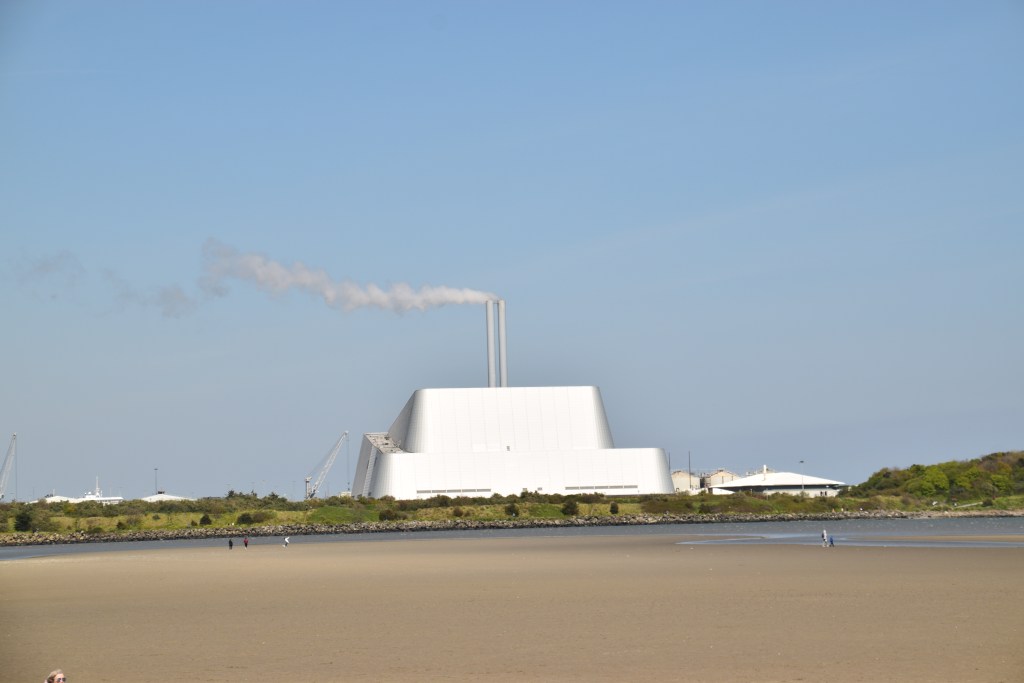
We’re going to head out around the base of the chimneys for the Great South Wall Walk. Himself doesn’t approve – he thinks I’m mad bringing you out there when we’ve so much else to see and do today. It’s a bit ambitious I’ll admit (grudgingly!) and going to take at least 2 – 2.5 hours. Its not a loop – we’ll be coming back the same way – so you can change your mind any time and just turn around…


When the tide is out you can’t actually see the sea! It feels as though you could walk to Wales!! The beach is great for a stroll at low tide. However, if you don’t know the area, its best to stay close enough along the shore – its very easy to get trapped out there when the tide turns.

You can leave the path for a short time and take a trail through Irishtown Nature Park. Brent Geese winter here before returning making the 8000km trip to Canada for breeding. They fly via Iceland – a mere 1300km and 20 hour journey (so no more moaning about the length of the walk!!). There’s lots more to see, both up here and along the shore – catfish, seals, herons, terns, curlews, skylarks, cormorants and guillemots……


Whatever path you take you will end up at Poolbeg Beach.

We’re right beside the chimneys… (they definitely need a bit of TLC!!)

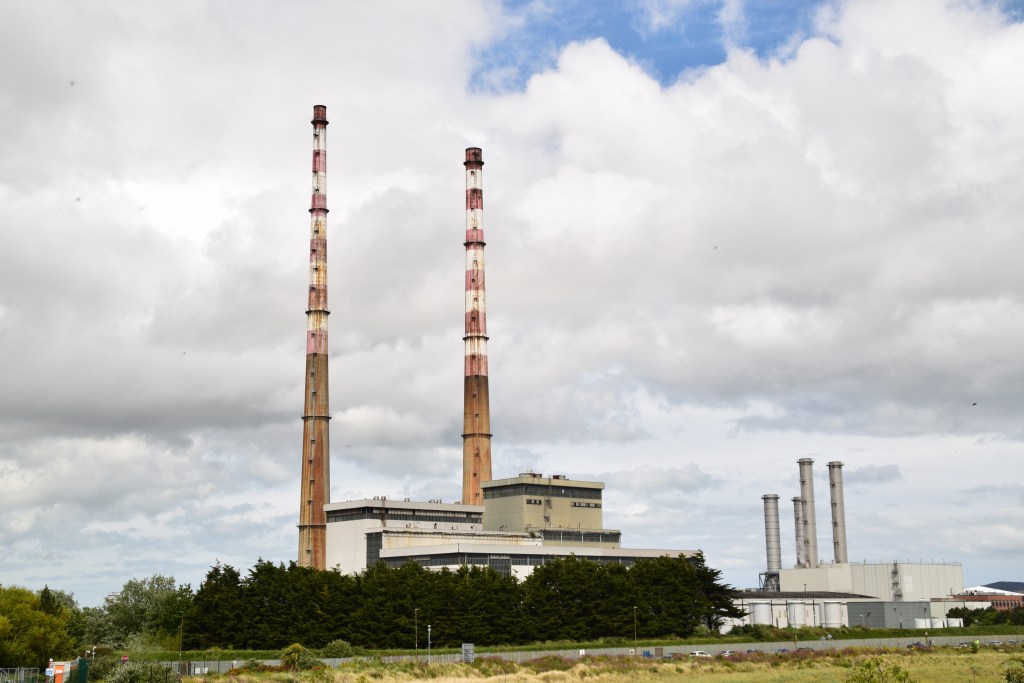
Here’s one of those palms – this is what I thought the sculpture back at the beach represented!

We round the corner and the full Great South Wall comes in to view….



The Great South Wall was built in 1768 to prevent the silting up of Dublin Bay. Extending almost 4 miles into the bay, it was the world’s longest sea wall at the time. The port has grown around the wall, reducing its impact but its still a good 45 minute walk from here, out to the lighthouse and back.
I know you’re dying for a coffee but you have to wait until you get back!!


It’s lovely here today but at high tide and in bad weather, the pier gets beaten with waves. Not much fun being wet and blown about (although kids love it!)

Recognise this???? Remember Realt na Mara – the statue over on North Bull Wall – and Dollymount Strand (#2). So close! We are literally just across the River Liffey.

There’s the end of the Bull Wall, disappearing under the turning tide…
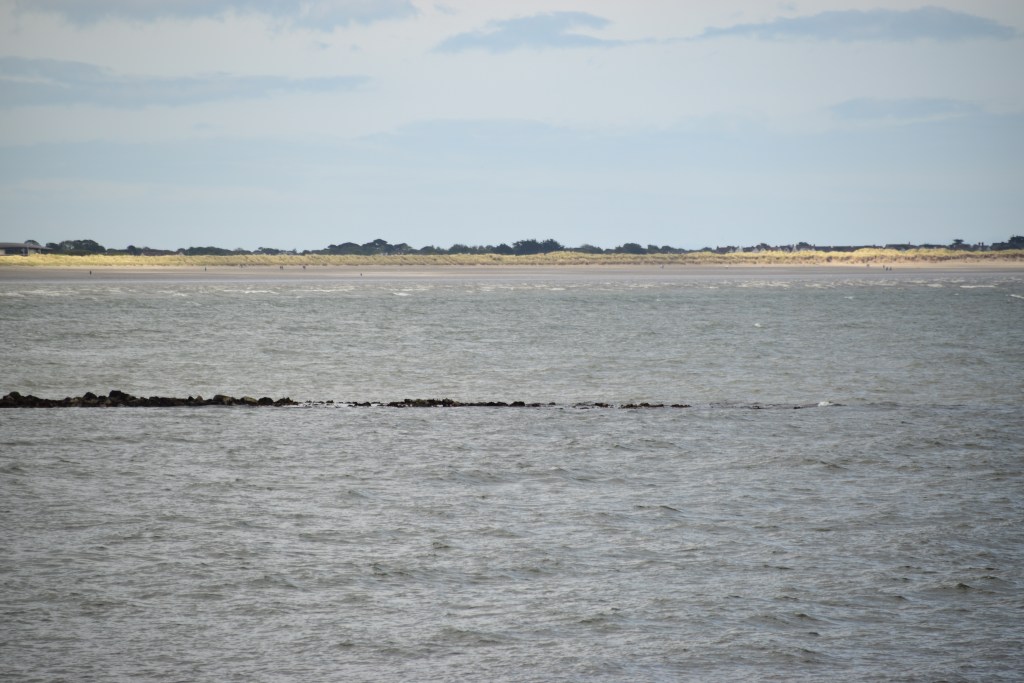
Hi guys… (black guillemots)

The red lighthouse indicates ‘port side’ for ships entering Dublin Bay while the North Bull Lighthouse is painted green to indicate ‘starboard’.


Fancy a swim?
The original lighthouse – a candle lighthouse – was built in 1768. This one replaced it in 1820.
Just look at the views from here!!!
Ahead of us is the Bailey Lighthouse on Howth Head….

Over on our left is Dun Laoghaire Harbour and Dalkey Island (tune in for #4 and #5!!)


Back behind us we have views of the Liffey and Dublin port
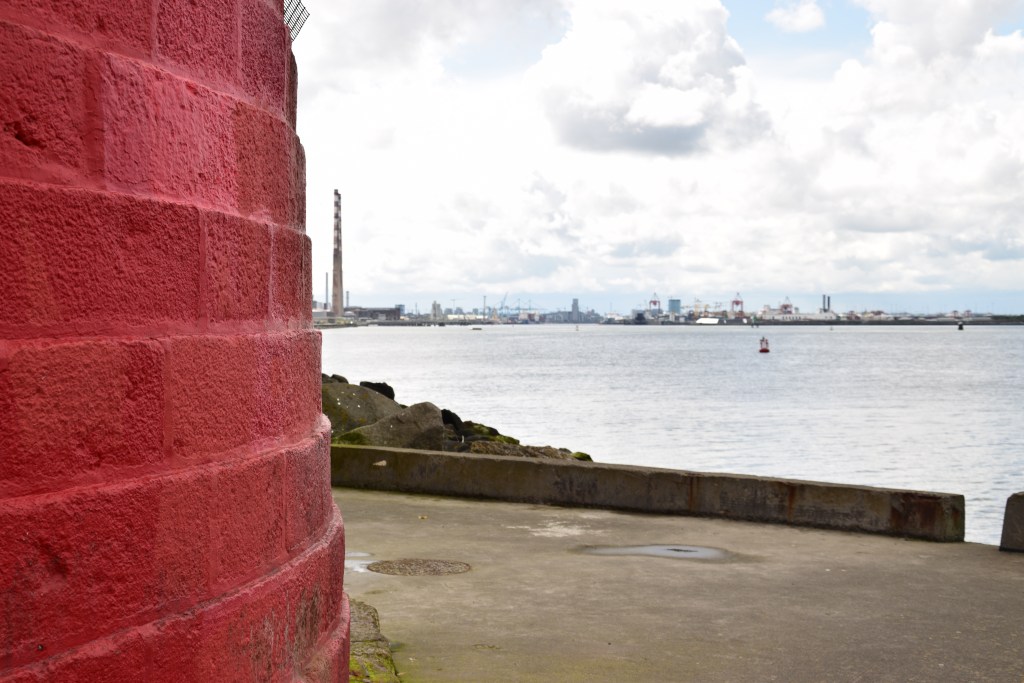
We’re back and ready for that coffee! Mr. Hobb sells those little packets of 3 or 4 biscuits – you know the ones – hope Tom gets me the fruit shorties! (I’ve also noticed a bottle of Baileys on occasion – can’t beat a Bailey’s coffee! But we’ve too far to go!!)

We’ll return to Sandymount Strand along the same path.
HOWEVER! In the interest of full disclosure there are options available. You’ll notice cars parked close to the wall and at the small beaches – there is road access around the back of the chimneys. Walkers can cut across the sand at low tide and make straight for the promenade back at Sandymount. This will shorten the route but make sure to check tide times beforehand.


All this area is reclaimed land – constructed on a Dublin Corporation landfill site. I wonder who had the vision to turn a rubbish dump into such a wonderful amenity!
In 1760, a caretaker’s lodge was built to assist those working on the construction of the Great South Wall. John Pidgeon was appointed caretaker in 1761. The ‘d’ was later dropped from the name but this area, to this day, has always been know as the Pigeon House
All is calm today but needless to say…..
…. if it’s wind you’re after….



Back at Sandymount Strand, you’ll be glad to know you’ve walked over 10km and more than covered your 10,000 daily steps! But no stopping now! We are going to turn right and a 10 -15 minutes walk brings us to the village of Ringsend.
We’re just about 2 kms from Dublin city centre but up until the 19th century, this was a distant hamlet, separated from the city by a belt of green fields. Long known for its strong community spirit, many families have lived here for generations. Its landscape of early 1900’s cottages, terraced houses and mid-1900’s council flats is often used as a movie location to replicate inner city conditions. The generations of working class residents, up on their heavenly perches, must be laughing their socks off at the property prices here today! The influx of Google and other tech companies just up the road has brought an infusion of money and has turned the village into a highly desirable and fashionable neighbourhood.
We’re on Ringsend Bridge, crossing the River Dodder – we’re heading towards that new development in the distance….

A bit of community activity along the river bank…..

There’s lots more colour around the corner…..
We’ve arrived at Grand Canal Dock – an area of the city that has seen incredible redevelopment in the past 20 years or so.
The little enclosed harbour is unrecognisable nowadays, surrounded by offices, apartment blocks, hotels and eateries.
Grand Canal Square is now one of the largest paved public spaces in the city. With one side facing out on to the water, the layout has been designed to accommodate public events such as performances and festivals.

I appreciate the necessity of sponsorship for the arts but I really wish it didn’t include naming rights!
The Grand Canal Theatre mightn’t have been long enough on the go for Dubliners to develop emotional and sentimental ties but we still disliked the name change! Now known alas as the Bord Gáis Energy Theatre (awful!), this is actually the biggest fixed-seat venue in the country.
In the midst of all this development, I love the signs of old Dublin…. kids jumping off the bridge, Ringsend Church in the distance……
….. and always, always, the chimneys……

Cast your eyes across the bridge towards Bolands Flour Mill. Now dwarfed by mini-skyscrapers, the mill once dominated the skyline at Ringsend and was a huge employer for generations of locals.
The mill played a key role in the 1916 Easter Rising. Eamon De Valera – a future president of the republic – was in command of this area of the city (the intention being to block any enemy force which might come from the Ringsend direction).
The Rising (the first in Ireland since the 1798 rebellion) started on April 24 and lasted 5 days. It was carried out by members of both the Irish Republican Brotherhood and the Irish Citizens Army. Because of a shortage of guns and mixed communication, only about 1250 men took part. The British army was taken by surprise but were soon responding with artillery fire. The Irish were no match and the leaders surrendered after a few days. Most leaders were sentenced to death.
At first, the Easter Rising had little home support. After its leaders were executed they became heroes and though the rebellion was actually a failure, it became a defining moment and a turning point in the struggle for Irish independence.
Eamonn de Valera was one of only two leaders who escaped the death sentence. The most usual explanation is that he was born in New York and therefore could not be executed as a traitor as he held no British citizenship. He himself believed that it was because he surrendered later than the others and the British prime minister wanted no further executions. Countess Markiewicz had her death sentence reduced to a life prison sentence on account of her gender.
The mill remained a major local employer until 2001. The facade and some of the warehouses are protected and will thankfully remain in place as the surrounding area succumbs to ‘progress’.


The redevelopment buzz here has drawn in a host of major tech firms, including Google, Facebook, LinkedIn and Stripe. The big names mingle with old side streets and railway lines, ancient warehouses and terraced homes.
We’re up on the main road, passing Bolands Mill on our right and heading back towards Ringsend…..


We have to get back to Sandymount Strand. When we reach Ringsend Bridge we veer right onto the Dodder Walk. This path, about 8kms in length, heads off inland towards the suburbs (don’t panic!! – we’re only going a little way!!). The Dodder is one of the three main rivers in Dublin, the others being the Liffey, of which the Dodder is the largest tributary, and the Tolka.
As we set off along the path, we’ve Shelbourne Park Greyhound Stadium on our right….

The old gas storage cylinder has been converted into apartments
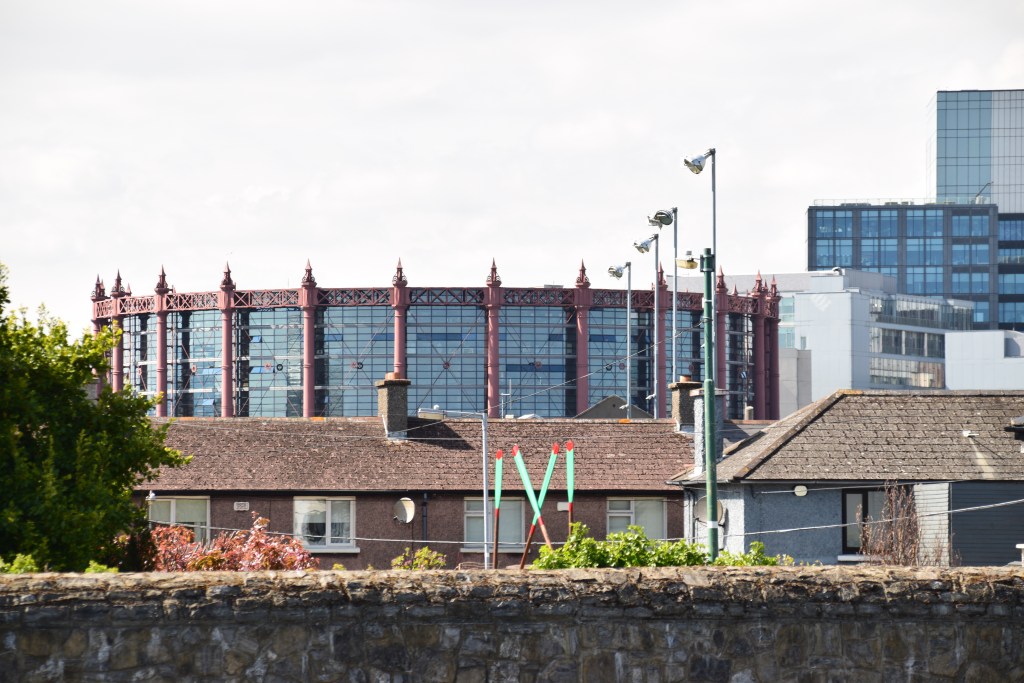
The chimneys are on our left – never far away!

The Aviva Sports Stadium (another awful sponsored name!) with a capacity for 51,700 spectators, looms above us.
The pumphouse on our left was built in 1881 to pump sewage to the Ringsend wastewater treatment plant.




Time to leave the path and veer back in through Sandymount Village.
This wasn’t always the wealthy urban village of today. Back in the 18th century the area was dominated by an industrial brickworks which turned local soil into bricks for the grand Georgian Squares that were being laid out just a few miles away. A 1766 parliamentary return showed just 10 families living here but gradually a small village developed – known as Brickfield Town. The triangular Green was to become the heart of the village.
Meanwhile, the local landlord, Lord Fitzwilliam, was worried that his land was being washed away into the bay so in the late 1700’s, he built and embankment with a raised road and a sea wall. Now the land was safe for construction and fine houses and villas began to appear.
The construction of the Dublin – Kingstown railway in 1834 was hugely important for the expansion of the village. A horse drawn tram service from the city centre began in 1872. In 1901 the horses were replaced with electricity – exciting times!
(Some trivia – the trams were not numbered but had a name plate at the front to indicate the destination. Symbols were also used and a green half crescent indicated to the many illiterate Dubliners of the time that this was indeed the tram to Sandymount!)
From the village, it’s a short stroll back to the strand. Well done!!

Small Stuff
The Poolbeg Lighthouse Walk is 11km in length from Sandymount. The Wall itself is just about 2km.
The going is flat but the surface can be uneven, particularly the cobblestones out on the wall.
Make sure to pack for all 4 seasons. Bring a raincoat and be prepared for exposed winds on the wall. Avoid the wall during heavy rainfall and heavy winds.
There are no facilities on the walk. The nearest public toilets are back on the strand – near the Martello Tower.
The only refreshments available on the route are those from the coffee truck which may be at the start of the wall during peak times.
Where we’ve been:
#1 – Howth

#2 – Dollymount

Where we’re going to:
Next time, we’re off to beautiful Dun Laoghaire





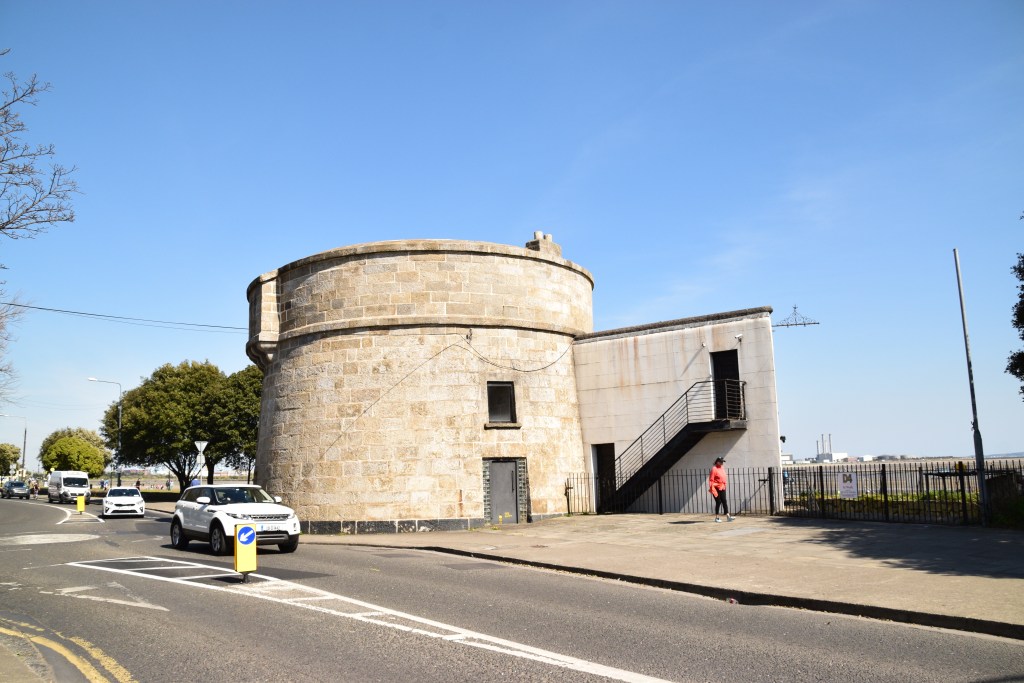













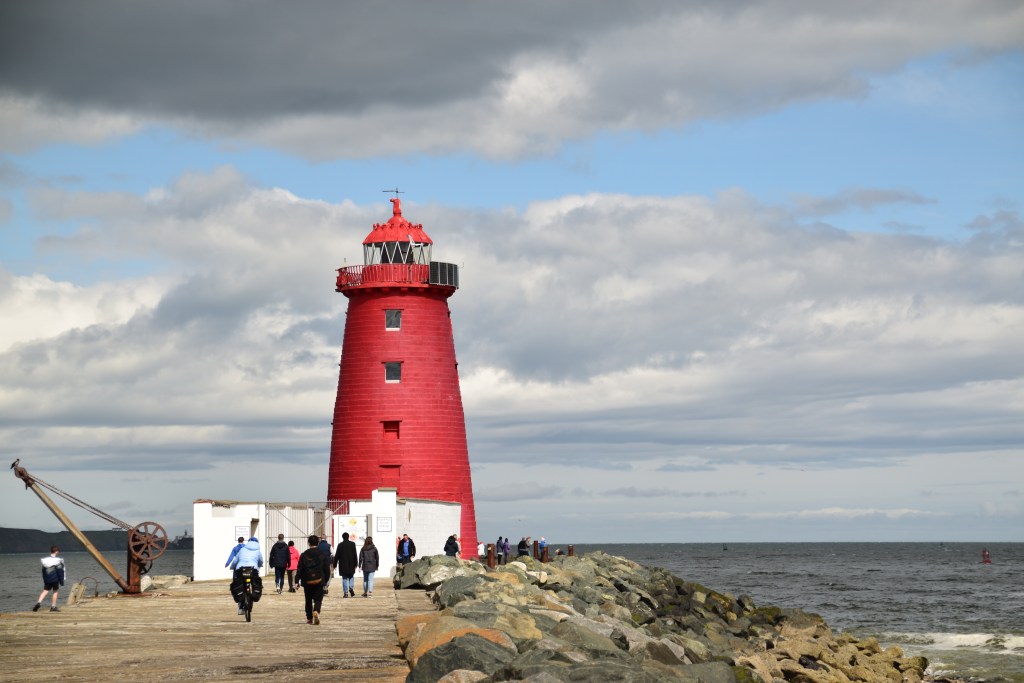







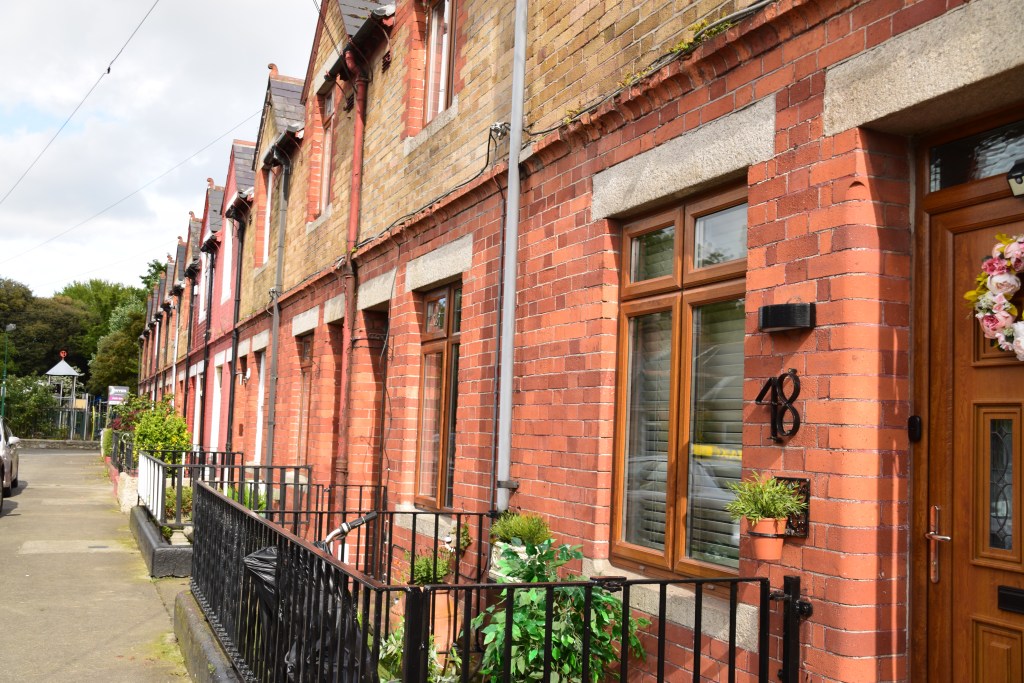






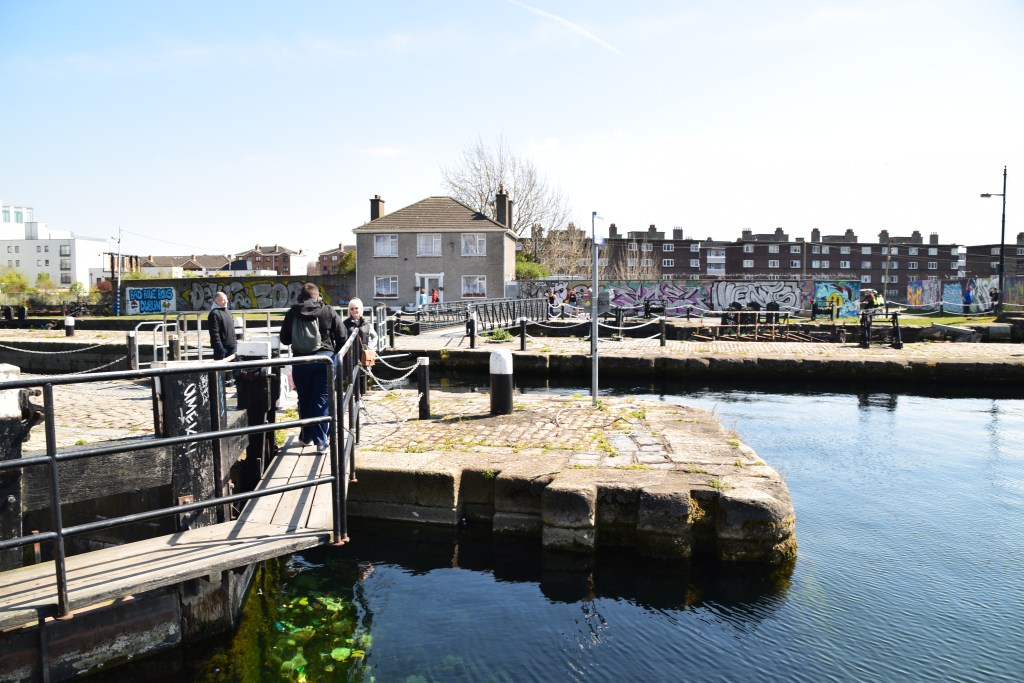
































Another beautiful walk Marie. Wish I was there to do it. But, yeah, which ploitician’s palms were greased when they approved the Death Star. You have to wonder what goes through some bureaucrat’s minds. Thanks for sharing. Hope all is well with you and your family. Allan
Thank you Allan – glad you enjoyed….
Yes- we’re all a bit more positive here – things opening up and people on the move around the country. Hoping for a good summer at home…. How are things with you?
Great post and wonderful pictures. You’ve given readers a whole new idea of what Dublin is all about I’m sure. Love that pink bicycle, pink wellies and pink something else.
That would have been a great photo for the pink month of colour challenge!!!
Wow, where do I start? What a varied walk! Too long for me in reality but virtually I can manage any distance 😆 I’m with you all in disliking the incinerator but I have to say the Awaiting the Mariner sculpture rather appealed to me. I think you have to be a local to love the chimneys and I totally get that 🙂
The modern redevelopments remind me of the area around Kings Cross in London, down to the repurposing of the gas cylinders which I was pleased to see. Great that they’re preserving the old flour mill too, and the recording studios were interesting to spot along the way. Thanks for a great tour, and I look forward to the next one!
I’m delighted they haven’t obliterated everything – there are a few old warehouses left along the quays also which were eyesores but now look great..
A great place to walk. I would love to jump in our boat and sail across the ocean from Nova Scotia to Dublin.😍
And lots of places here for you to moor!!!!
Not sure I’d fancy that journey in a boat though – I’ll wave to you from the plane!!1
Yes ..maybe I could swim 🏊♂️ across the ocean LOL 😆
.
🏊♀️🏊♀️🏊♀️🏊♀️🏊♀️
What a lovely walk 🙂 Being landlocked here in Cambridgeshire, we don’t have them like that!
We are very, very lucky here – so much choice around the bay. We really appreciated being beside the sea during lockdown.
I love the Great South Wall and the beauty of walking it all the way out to Poolbeg Lighthouse. When you reach the lighthouse at the end of the pier you’ll have stunning views no matter which way you look. Your photos bring back lots of amazing memories from my years in Dublin. Look forward to your next post, Marie 🙂 Aiva xxx
The best part is the view I think – the city from a completely different angle… XXXMarie
Well Marie, as a native of Sandymount , I want to thank you . You truly did justice to the wealth of experiences granted by this , almost city, neighbourhood . While I loved all of the photos I have to highlight the Dodder Walk which is seldom featured. Ringsend ( Raytown) has such a warm and wonderful neighbourhood spirit . The library played a part in my early years (Nancy Drew mystery books come to mind). The gasometer on South Lotts Road evokes many happy memories walking with my pals to meet school pals. The striped chimneys became renamed by our daughter as ‘ granny’s chimneys”. She could always see them as we drove home to my parents house to visit . Affectionately I hear her three year old son calling them the same .. sweet. The beaches at Poolbeg were where I learnt to drive! I circled and circled around the car park at the Shelley Banks! Years have been good to the area. Reclaimed land has provided new amenities for all . The Incinerator reminds me of the Guggenheim in Bilbao Harbour, alas the function and smell do not compare. … pity.
Lock down has put this whole area on the map for walkers .. hopefully this will continue to be maintained well. Hopefully the neighbourhoods will survive the future .
Thank you Marie 🥰
Praise from a native is praise indeed!! I’m chuffed Teresa that I got it so right! The Dodder walk was a lockdown discovery for us – I don’t even know how we came across it.. You must have seen huge changes over the … years (nearly said decades but I’m being kind 😖😂 🤣). You’re right about the incinerator – it is like the Guggenheim – much nicer than ‘Death Star! Here’s hoping that ‘granny’s chimneys’ will still be there for your greatgrandchildren!! XXXMarie 🥰 😘
Epic post Marie and it brought back great memories of my 18 months or so living in Dublin just around the corner from Windmill Lane. Ringsend, Grand Canal Dock and Irishtown became very familiar to me, particularly many hours coaching athletics at Irishtown Stadium then supping pints in the Oarsman on the way home.
Brilliant – how long ago was that Roy? There’s been huge changes around there in the past 10/15 years…..
Jan 2008 – mid 2009. I’m sorry it didn’t work out long term.
There’s been ongoing development then since your time – I wonder what you’d think of it…..
Yes, the economic crash had stopped everything in its tracks just then. The building along the quays had just stopped dead, the Bord Gais Theatre was unfinished, the Marker Hotel etc. A lot of people out of work just then as well. Now I doubt I could afford to live in Dublin any more.
Ah well then you’d definitely see changes were you to revisit –
Rents are absurd now – really dreadful…. and the expected post covid 2021 property crash failed to materialise…. We’d nothing in the news bar Covid for a year – now the whole housing crisis is coming back to the fore…